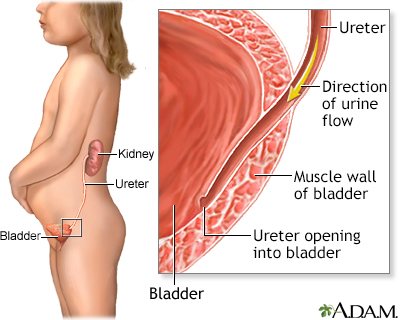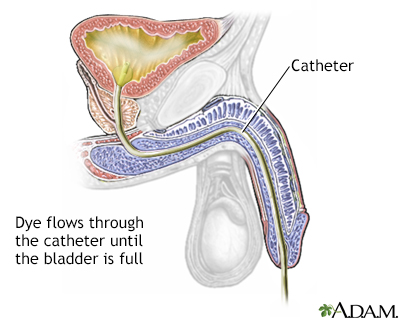Retrograde cystography
Cystography - retrograde; Cystogram
Retrograde cystography is a detailed x-ray of the bladder. Contrast dye is placed into the bladder through the urethra. The urethra is the tube that carries urine from the bladder to the outside of the body.
Images


I Would Like to Learn About:
How the Test is Performed
You will lie on a table. A numbing medicine is applied to the opening to your urethra. A flexible tube (catheter) is inserted through your urethra into the bladder. Contrast dye flows through the tube until your bladder is full or you tell the technician that your bladder feels full.
When the bladder is full, you are placed in different positions so that x-rays can be taken. A final x-ray is taken once the catheter is removed and you have emptied your bladder. This reveals how well your bladder empties.
The test takes about 30 to 60 minutes.
How to Prepare for the Test
You must sign an informed consent form. You must empty your bladder before the test. You will be asked questions to determine if you may have an allergic reaction to the contrast dye, or if you have a current infection that could make inserting the catheter difficult.
How the Test will Feel
You may feel some pressure when the catheter is inserted. You will feel an urge to urinate when the contrast dye enters the bladder. The person performing the test will stop the flow when the pressure becomes uncomfortable. The urge to urinate will continue throughout the test.
After the test, the area where the catheter was placed may feel sore when you urinate.
Why the Test is Performed
You may need this test to examine your bladder for problems such as holes or tears, or to find out why you have repeated bladder infections. It is also used to look for problems such as:
- Abnormal connections between bladder tissue and a nearby structure (bladder fistulae)
- Bladder stones
- Pouch-like sacs called diverticula on the walls of the bladder or urethra
- Tumor of the bladder
- Urinary tract infection
- Vesicoureteric reflux (urine flowing backward from the bladder to the ureter)
Normal Results
The bladder appears normal.
What Abnormal Results Mean
Abnormal results may be due to:
- Bladder stones
- Blood clots
- Diverticula
- Infection or inflammation
- Lesions
- Vesicoureteric reflux
Risks
There is some risk for infection from the catheter. Symptoms may include:
- Burning during urination (after the first day)
- Chills
- Decreased blood pressure (hypotension)
- Fever
- Increased heart rate
- Increased breathing rate
The amount of radiation exposure is similar to that of other x-rays. As with any radiation exposure, nursing or pregnant women should only have this test if it is determined that the benefits outweigh the risks.
Considerations
In males, testicles are shielded from the x-rays.
This test is not performed very often. It is most often done along with CT scan imaging for better resolution. Voiding cystourethrogram (VCUG) or cystoscopy is used more often.
Related Information
X-rayDiverticulitis
Reflux nephropathy
Urinary tract infection - adults
Bladder stones
Blood clots
References
Bishoff JT, Rastinehad AR. Urinary tract imaging: basic principles of CT, MRI, and plain film imaging. In: Partin AW, Domochowski RR, Kavoussi LR, Peters CA, eds. Campbell-Walsh-Wein Urology. 12th ed. Philadelphia, PA: Elsevier; 2021:chap 3.
Davis JE, Silverman MA. Urologic procedures. In: Roberts JR, Custalow CB, Thomsen TW, eds. Roberts and Hedges' Clinical Procedures in Emergency Medicine and Acute Care. 7th ed. Philadelphia, PA: Elsevier; 2019:chap 55.
Zagoria RJ, Dyer R, Brady C. An introduction to radiologic methods. In: Zagoria RJ, Dyer R, Brady C, eds. Genitourinary Imaging: The Requisites. 3rd ed. Philadelphia, PA: Elsevier; 2016:chap 1.
BACK TO TOPReview Date: 1/1/2023
Reviewed By: Kelly L. Stratton, MD, FACS, Associate Professor, Department of Urology, University of Oklahoma Health Sciences Center, Oklahoma City, OK. Also reviewed by David C. Dugdale, MD, Medical Director, Brenda Conaway, Editorial Director, and the A.D.A.M. Editorial team.

Health Content Provider
06/01/2025
|
A.D.A.M., Inc. is accredited by URAC, for Health Content Provider (www.urac.org). URAC's accreditation program is an independent audit to verify that A.D.A.M. follows rigorous standards of quality and accountability. A.D.A.M. is among the first to achieve this important distinction for online health information and services. Learn more about A.D.A.M.'s editorial policy, editorial process and privacy policy. A.D.A.M. is also a founding member of Hi-Ethics. This site complied with the HONcode standard for trustworthy health information from 1995 to 2022, after which HON (Health On the Net, a not-for-profit organization that promoted transparent and reliable health information online) was discontinued. |
The information provided herein should not be used during any medical emergency or for the diagnosis or treatment of any medical condition. A licensed medical professional should be consulted for diagnosis and treatment of any and all medical conditions. Links to other sites are provided for information only -- they do not constitute endorsements of those other sites. © 1997- 2024 A.D.A.M., a business unit of Ebix, Inc. Any duplication or distribution of the information contained herein is strictly prohibited.
